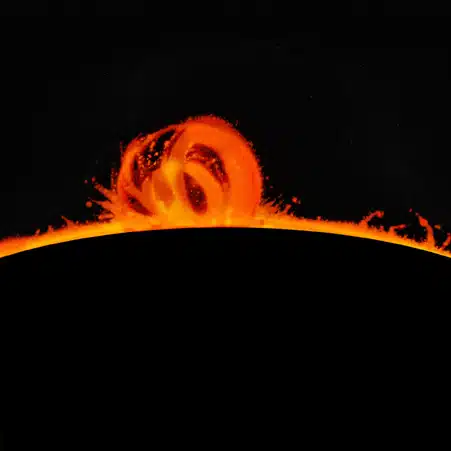Astronomers using the Anglo-Australian Telescope have found the first signs of weather outside the Solar System, on objects called ‘brown dwarfs’, which are like a cross between a Jupiter-like planet and a star.
Astronomers have found the first hints that failed stars known as ‘brown dwarfs’ may have weather patterns with winds, clouds and storms. This was announced today by Dr Chris Tinney at ScienceNOW! in Melbourne
Dr Tinney of the Anglo-Australian Observatory and Mr Andrew Tolley, a student at the University of Oxford, recently observed a brown dwarf and noted changes in its surface chemistry as it rotated. They made their observations with Australia’s largest optical telescope, the Anglo-Australian Telescope (AAT), located at Siding Spring outside Coonabarabran NSW.
Brown dwarfs are failed stars with masses in between that of Jupiter-like planets and normal stars. For decades, scientists have suspected that brown dwarfs exist but the first confirmed detection came only a few years ago. Today, after 30 years of searching, less than 50 brown dwarfs have been discovered. Of these, only a handful are bright enough and close enough to be studied for weather.
Tinney’s team is leading Southern Hemisphere attempts to learn more about brown dwarfs. They are very faint, and extremely difficult to detect, and for Tinney and Tolley to have noted surface changes is remarkable.
Brown dwarfs never made it as stars, being too small to light up their nuclear furnaces. Instead, they just smoulder away in space at temperatures below 2000 degrees — less than a third that of a typical star like the sun. ‘Proper’ stars are so hot that their surfaces are a completely smooth mix of vapourised material. But the outer layers of brown dwarfs are cool enough for chemicals to ‘rain’ out as smoke-like particles.
Tinney said, “Brown dwarfs are too small and far away to see the clouds. We detected them indirectly through the effects they have on the brown dwarf’s atmosphere. We looked for a changing pattern of chemistry in the atmosphere of one brown dwarf, called LP944-20, as it rotated.”
With a special instrument developed by the AAT, called the Taurus Tuneable Filter, Tinney and Tolley were able to ‘tune into’ a very narrow wavelength band and accurately measure tiny fluctuations. The narrow band chosen matched that of a tracer molecule called titanium oxide. The strength of this tracer allowed astronomers to track the formation of cloud particles.
Now that the technique has been honed, the astronomers are looking to other brown dwarfs. “We plan to study at least two more brown dwarfs in the next few months,” Tinney concluded.
Further information including graphics are available from the AAO website www.aao.gov.au
Photos and background information will be available on the ScienceNOW! website from the 7 May 1999 on www.asnevents.net.au/sciencenow
Background material on Brown dwarfs
Brown dwarfs are objects formed in the same way as stars, from the same material as stars, but which do not have the critical mass required to burn nuclear fuel like stars. That critical mass is about seven hundredths of a solar mass (or equivalently seventy Jupiter masses).
The existence of brown dwarfs was first proposed by Dr Shiv Kumar in 1963, though the name “brown dwarf” was only coined some years later by Dr Jill Tarter (now more widely known for her work on the Search for Extra-terrestrial Intelligence). The first bona fide brown dwarf discoveries were announced in 1995, at the same meeting in Florence, Italy, where the first extra-solar planet was announced. In the years since, approximately 50 more brown dwarfs have been discovered.
Theorists have predicted the presence of dust in some cool brown dwarfs for several years, however the recent discovery that brown dwarfs also rotate rapidly with periods of hours, has highlighted the likelihood that brown dwarfs may show weather patterns like the giant planets in our own Solar System.
Background Material on Titanium Oxide (TiO)
TiO is the dominant source of spectral features in cool stars and warm brown dwarfs. At temperatures below about 2000 degrees, however, a range of materials can condense out of a brown dwarf’s atmosphere, several of which contain titanium. This “soaks up” the titanium which would otherwise exist as titanium oxide, weakening the titanium oxide spectral features. The chemicals which can condense out of the atmosphere to make this happen include Ti2O3, Ti4O7, and CaTiO3. While the first exist on Earth only as man made chemicals, the latter is actually a naturally occurring mineral called perovskite – though in brown dwarf atmospheres it forms as micrometre-sized smoke particles, rather than as rocks!
Background Material on the Anglo-Australian Observatory
The Anglo-Australian operates two optical telescopes at Siding Spring Observatory, the 3.9-metre Anglo-Australian Telescope (now in its 25 year of operation) and the 1.2-metre UK Schmidt Telescope. The AAO also operates a laboratory in the Sydney suburb of Epping. The AAO operates under an agreement between the Governments of Australia and Britain.





 Fresh Science is on hold for 2022. We will be back in 2023.
Fresh Science is on hold for 2022. We will be back in 2023.